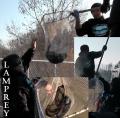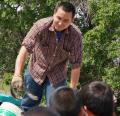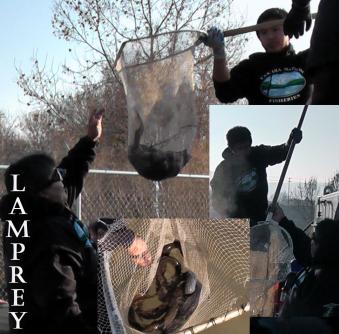The Yakama Nation is working to restore natural production of Pacific lamprey to a level that will provide robust species abundance, significant ecological contributions and meaningful harvest within the Yakama Nations Ceded Lands and in the Usual and Accustomed areas.
We are developing a long-term Management and Action Plan, specific to Pacific lamprey, in cooperation with local and regional government entities and other ongoing efforts conducted by the Nez Perce, Umatilla, and Warm Springs Tribes. The plan is consistent with the Columbia River Inter-Tribal Fisheries Commission Pacific Lamprey Tribal Recovery Plan, the U.S. Fish and Wildlife Service Conservation Initiative, and the Lamprey Management Plans of Chelan County, Douglas County and Grant County Public Utility Districts.
Program Objectives over the next 10-years:
-
Document historic distribution of adult lamprey based on historical records, literature reviews and oral
interviews, then compare with known current distribution. - Participate in and contribute to regional consistency in data collection, data management, analysis and reporting.
- Document status of larval Pacific lamprey with presence/absence surveys to determine current distribution.
-
Document biologic condition, migration behaviors and environmental cues that trigger
migration for both adult and juvenile Pacific lamprey. -
Identify habitat characteristics that are preferred at various life stages and determine the extent
these habitats are available and are being utilized (habitat mapping). -
Identify and inventory all known and potential limiting factors, and current threats existing in
tributary habitats. Develop and implement a Pacific Lamprey Action Plan for the following
subbasins: Methow, Entiat, Wenatchee, Crab Creek, Yakima, Rock Creek, Klickitat, White
Salmon, Wind, and Little White Salmon (including all perennial tributary streams to the Columbia
River within the Yakama Nation Ceded Lands). -
To increase larval abundance in tributary streams, implement a pilot adult Pacific lamprey
translocation program from main-stem Columbia River hydro-electric projects into various
subbasins (to be determined) and evaluate methodology and potential ecological benefits and risks of expanding this program as appropriate. - Evaluate the potential for adult Translocation, and participate in the development of supplementation / artificial propagation techniques of Pacific lamprey.
The Yakma Nation Pacific Lamprey Project is just beginning to develop. There is a rapidly evolving regional awareness of the issues surrounding these fish, but basic information is needed and there is much work to be completed in regional coordination, in data collection methods, data interpretation and reporting formats. Given this, it is impossible to describe all aspects over the next 10-years. Adaptive Management will play a significant role in the development and implementation.
The Yakama Nation Pacific Lamprey Program is developing over three phases: Phase 1 occurred in years 2009-2010, Phase 2 in years 2011-2012 and Phase 3 planned for years 2013-2017. In general, Phase 1 focused on conducting surveys, refining regionally accepted survey protocols, developing cooperative relationships with local and regional entities and continuing to develop and refine YNPLP objectives and future work elements. Phase 2 continued the Phase 1 effort and expanded our work geographically. During Phase 2, we emphasized the identification of habitat limiting factors within the various subbasins and began development of a comprehensive and detailed restoration action plan for each of these subbasins. In Phase 3, we anticipate a greater emphasis in actively enhancing and restoring Pacific lamprey habitats and documenting progress, as well as more refined, quantitative estimates of abundance and distribution of adult and juvenile lamprey within key watersheds of the Yakama Nation Ceded Lands.
Through 2009-2012, the YNPLP obtained basic information relevant to Objectives 1–6, as described above, by completing preliminary field surveys, beginning in the Klickitat, Yakima, Wenatchee and Entiat subbasins. Over time, as our Program grows in experience and regional coordination increases, we intend to expand field surveys to other streams and subbasins and more aggressively continue work relevant to Objectives 7 and 8. Throughout this timeframe, the YNPLP will continue local and regional coordination with key parties interested in lamprey restoration as a primary means to gain a high level of efficiency and effectiveness toward achieving our goal.
2012: Successfully completed artificial propagation of Pacific lamprey at Marion Drain and Prosser Hatchery facilities to produce multiple thousands of larvae, translocated 15 adults from Lower Columbia River into Satus Creek for natural reproduction, and documented current distribution of larvae/juveniles in Yakima, Wenatchee, Entiat, and White Salmon basins, including entrainment in diversions/canals.
For a library of queryable, downloadable reports and presentations, click here.





